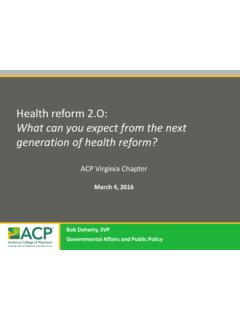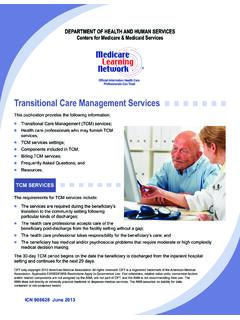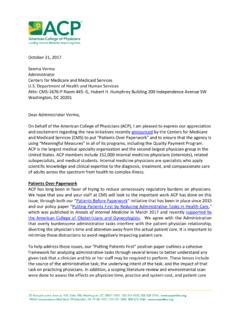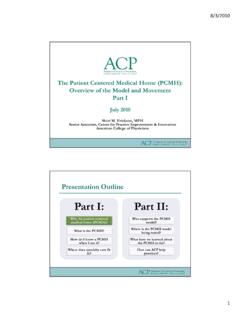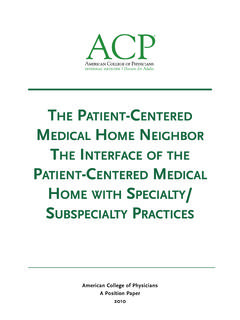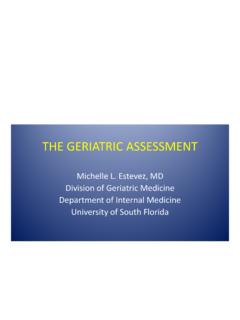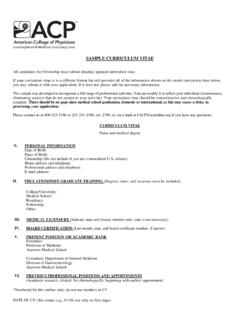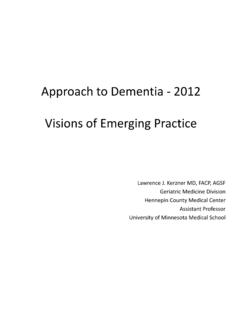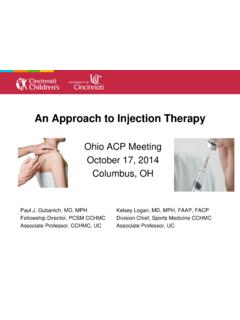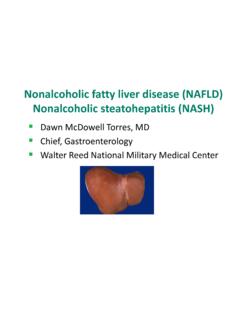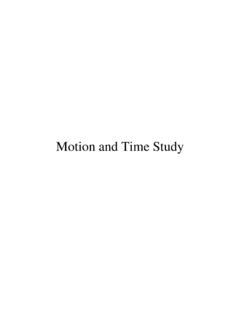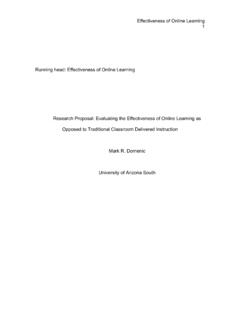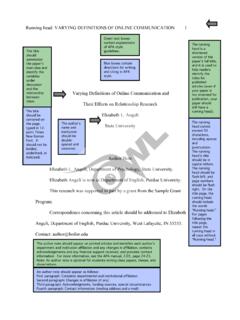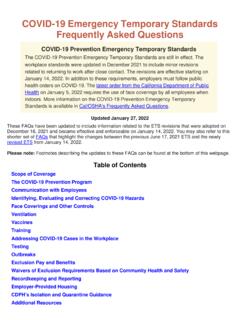Transcription of CLIA & Your Laboratory - American College of Physicians
1 ACP 2014 CLIA & Your Laboratory A Guide for Physicians and Their Staff November 2014 ACP 2014 2 Introduction The American College of Physicians (ACP) welcomes your interest in this guide to the Clinical Laboratory Improvement Amendments of 1988 (CLIA 88). We hope that you will find it helpful in answering many of your questions regarding regulations for clinical Laboratory testing. These CLIA regulations are far-reaching, and now regulate physician -office Laboratory (POL) testing on a national scale. ACP originally published this guide in 1988. It has been revised periodically to reflect the changes made to the regulations as a result of its implementation and ongoing modifications to CLIA. Among these changes are: The creation of a second moderate testing category A revised waived category Compliance measures for states that are CLIA-exempt Requirements for lab director certification for high-complexity labs An updated fee schedule for CLIA certificates This guide has been divided into nine chapters: The first chapter, The Origin of CLIA 88: An Overview, traces the legislative and regulatory history of CLIA 88 and details some of its key components.
2 The second chapter, The Implementation of CLIA 88, provides a step-by-step process for obtaining a CLIA certificate and the costs of the applicable certificate. The third chapter, Private-Sector and State Alternatives to Federal Certification, explains how POLs can meet federal standards, by becoming accredited by a nonprofit, private accreditation program, such as COLA or a CLIA-exempt state agency. The fourth chapter, Waived, PPM, Moderate- and High-Complexity Testing: How Will I Be Regulated? details the four levels of regulation and the testing that can be performed in each category, and the applicable standards that must be met to comply with CLIA 88. The fifth chapter, The Proficiency Testing Requirements Under CLIA 88, describes proficiency testing (PT) and the standards that Physicians owning non-waived laboratories must meet to comply with the CLIA PT requirement.
3 The sixth chapter, Meeting the Quality Systems Standards, details the required quality control (QC) and quality assurance (QA) standards with which Physicians owning laboratories must comply. This chapter also addresses PT, test management and recordkeeping requirements. ACP 2014 3 The seventh chapter, Complying with the CLIA Personnel Standards, specifically outlines what testing personnel standards are needed to comply with the requisite moderate- a nd high-complexity testing personnel standards. The eighth chapter, The Inspection Process, details the process that is used to ensure that POLs are meeting CLIA standards. This chapter also illustrates the average cost of biennial inspections, and addresses the Alternative Quality Assessment Survey (AQAS) form.
4 The ninth chapter, The Enforcement of CLIA 88, details the enforcement procedures and sanctions that the Centers for Medicare and Medicaid Services (CMS) may use to enforce the QA standards. This guide follows a question and answer format. We hope that we have addressed most of your concerns about the Laboratory regulations in this guide. ACP members may call our toll-free hotline at 800/338-2746, if they have additional questions about complying with CLIA 88. ACP strives to assist its members in navigating the complex and often perplexing regulatory process. ACP has been a leader in reducing the regulatory burdens placed upon Physicians who operate their own in-office laboratories. These initiatives include: reduced pre-billing time ; the addition of a provider-performed microscopy category (PPM); the AQAS form, which is a written survey in lieu of an onsite inspection; revised personnel requirements; active involvement in COLA s expanded member services; and Medical Laboratory Evaluation a PT program which operates as a part of ACP.
5 All of these accomplishments have been made on behalf of the entire community of Physicians who operate in-office laboratories. Individual members of ACP benefit from the congressional advocacy provided by staff lobbyists and analysts. ACP staff also mediates with CMS staff and other federal officials on behalf of ACP members individual concerns: ACP members do not have to navigate regulatory territory alone. For specific questions about CLIA and your Laboratory , call ACP at 800/338-2746. ACP 2014 4 Chapter 1 The Origin of CLIA 88: An Overview Section The Legislative History of CLIA 88 1. How did the federal Quality Assurance (QA) standards for POLs originate? Before the enactment of CLIA 88, only hospital and independent laboratories were required to meet the federal QA standards mandated by CLIA 67.
6 Congress first signaled its concern about the accuracy of POL testing by mandating through the Omnibus Budget Reconciliation Act of 1987 (OBRA 87) that high volume POLs meet the same Medicare standards as commercial laboratories. It was clear that Congress definition of high volume laboratories would have included most POLs, and the task of writing such regulations fell to the Secretary of the Department of Health and Human Services (HHS). By including this last-minute mandate into OBRA 87, Congress made it clear that POLs no longer would be exempt from federal Q As. Physicians and the Laboratory community were forced to come to grips with the need for a workable approach to QA in office laboratories, and OBRA 87 served as the stick to force such action.
7 Following enactment of the OBRA 87 provisions, media investigations into Laboratory practices caught the attention of Congress. Perhaps most notable was a Pulitzer-prize winning series that was broadcasted by a Washington, , television station, and followed by a compelling article in the Feb. 2, 1987, edition of The Wall Street Journal that highlighted scandals involving several commercial laboratories which inaccurately analyzed Pap smears. Several women died from undetected cervical cancer because of these inaccurately analyzed tests. Of the tens of thousands of laboratories run by Physicians at that time , only a handful performed cytology testing, but the public demanded that Congress take action in response to these preventable deaths.
8 Congress reacted by holding oversight hearings which ultimately guided the drafting of CLIA 88, which later was signed into public law (PL 100-578) on Oct. 31, law is far-reaching and regulates POL testing on a national scale. 2. To whom does CLIA 88 apply? CLIA 88 applies to anyone who performs testing of human specimens for the diagnosis, prevention or treatment of disease or health problems. This includes everyone from Physicians performing the most basic tests ( , dipstick urinalysis) to the technicians working in POLs. The only exceptions are facilities that perform testing for forensic purposes, research laboratories that do not report patient results, and facilities that are certified by the Substance Abuse and Mental Health Services Administration (SAMHSA) to perform urine drug testing only.
9 ACP 2014 5 3. What were Congress key objectives in enacting CLIA 88? Supporters of CLIA 88 believe that it was based on the best of intentions: to protect patients from harm resulting from inaccurate testing. Additionally, the law was designed to assure that all laboratories were meeting reasonable quality standards that recognized the different levels of complexity of tests typically performed in POLs. Drafters of the law tried to design CLIA 88 so that the regulations would be workable and cost-effective, without jeopardizing access to in-office testing. CLIA 88 established requirements to improve the quality of Laboratory testing, including standards for the performance of Proficiency Testing (PT), Quality Control (QC), QA, patient-test management and personnel requirements.
10 4. What has been the effect of the CLIA 88 legislation? CLIA 88 had a significant adverse impact on the quality and accessibility of POL testing. Specifically, the CLIA regulations have affected the types of tests Physicians now are willing to offer in their office labs. To avoid the costs associated with CLIA regulations, many Physicians discontinued valuable in-office testing in the moderate-and high-complexity categories. The prompt receipt of such test results and the capability to evaluate specimens directly are useful to the physician and help to expedite decisions about appropriate patient care. As a result, patient s access to timely quality testing had been compromised. According to a 1995 survey performed by the American Medical Association (AMA) and six other specialty groups, percent of POLs had scaled back or completely eliminated Laboratory testing since the provisions took effect in 1988.
